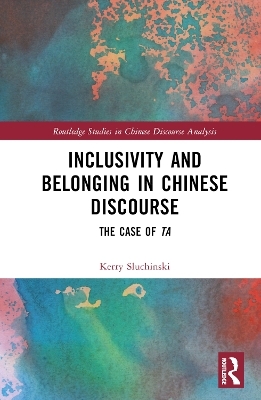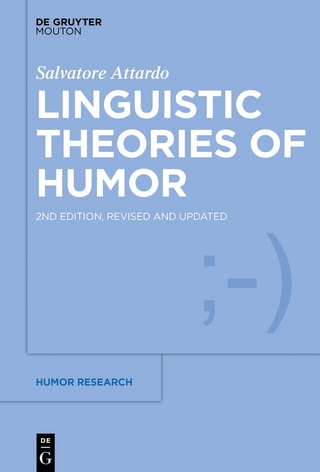
Inclusivity and Belonging in Chinese Discourse
Routledge (Verlag)
978-1-032-50431-5 (ISBN)
Inclusivity and Belonging in Chinese Discourse explores how recent language change in the third-person pronoun system of Mandarin Chinese is harnessed by netizens to construct spaces of (non-)belonging along a fluid continuum in the context of pro- and anti-LGBTQ discourses.
Grounded in stance, framing, and positioning theories, the monograph contributes to the notions of membership categorization and (co-)reference chains for identity construction. With a focus on newly emergent genderless third-person pronoun ta, written in pinyin, and the various noun and verb phrases which co-occur with the pronoun in specific contexts, this monograph shows how ta has become a conventionalized language practice accepted and implemented by language users of various identities, sexual orientations, and backgrounds for a vast array of interactional and communicative purposes. The monograph illustrates how ta is used in doing identity construction work for the self, another party involved in the interaction, and/or a third party external to the interaction, often simultaneously. That is, the specific function and referent of ta is defined through language users’ unique interpretations and the discourse community of use, resulting in a ‘chameleon-like’ pragmatically loaded pronoun which reflects the inherent fluidity of identity(ies).
This monograph will appeal to scholars, language researchers, and advanced graduate students concerned with inclusive language use in the Chinese context, particularly within discourse analysis, linguistics, sociolinguistics, and semantics. The book will also be valuable to professionals concerned with inclusive language and identity construction.
Kerry Sluchinski is a pragmatics and deixis-based East Asian linguist and discourse analyst whose general body of research focuses on the (de/re/co-) construction of identity and the use of referential forms on the Internet in Chinese, Korean, and Japanese.
List of Figures
List of Tables
Preface and Acknowledgements
PART 1: From Deviation to Conventionalization: A Genealogy of ta and (Chinese) Gender Identities
1. Introduction
1.1 From Classical to Modern: Third-Person Pronoun Syntactic Behaviour and Orthography up to 2003 and Beyond
1.1.1 Third-Person Pronoun Development
1.1.2 Syntactic Behaviour of the Third-Person Pronoun in Written Chinese
1.2 Early Beginnings: A Sample of Syntactic Structures of the ta Phenomenon in CMC
1.2.1 A Quantitative Look at Conventionalization: Syntactic Constructions of ta
1.2.2 A Quantitative Look at Conventionalization: Sentence Types
1.3 Modern Investigations: Discursive and Psycholinguistic Evidence Towards Conventionalization
2. Deviant or Conventional? Constructing Gender Identities in China and at Large
2.1 Homosociality vs Homosexuality
2.2 Tongzhi: The Genderless Comrades of Communism and Sexuality
2.3 X也 and 无也: ta’s Less Ubiquitous Counterpart and Most Recent Contender
2.4 Pronouns and Pragmatics: The Problem
2.4.1 Constructing Identity: Speaker, Addressee …Other?
2.4.2 Constructing Identity: Third-Person Pronoun and Referential Form Use by the Other
2.4.3 Constructing Identity: Third-Person Pronoun and Third-Person Noun Phrase Use for the Other
2.5 Research Questions
PART 2: Analytical Framework, Data, and Classification
3. Theoretical Underpinnings
3.1 Theories
3.1.1 A Framing, Positioning, and Stance Theories Framework
3.1.2 Adapted Appraisal Theory and Co-Reference Chains
3.1.3 Membership Categorization and Indexicality
3.2 Corpus
3.2.1 Data Origin and Software
3.2.2 Data Collection Procedure and Categorization
3.2.3 Discourse Types and Texts
4. Who is ta? A comparison of Pro- and Anti-LGBTQ Community Usage
4.1 Ta Categorization Schema – Methodology and Layers 1-2
4.2 Layer 3 - Quantitative Referent Categorization
4.2.1 Ta Categorization Schema in the Context of the Entire Corpus
4.2.2 Ta Categorization Schema Community by Community
4.3 Layer 3 - Qualitative Presentation of Quantitative Lexical Referents
4.4 Interim Summary
PART 3: Othering
5. Political Non-Belonging: ‘Othering’ and ‘Vagueness’ of ta in Anti- and Pro-LGBTQ Communities
5.1 Negative Stance and Non-Belonging
5.2 Explicit Othering: Analysis and Discussion
5.2.1 Refusing to Recognize an LGBTQ Individual’s Self-Ascribed Identity
5.2.2 Dehumanizing an LGBTQ Member
5.2.3 Downgrading Social Integrity
5.2.4 Co-Constructing ‘Other’ Identity
5.3 Implicit Othering: Analysis and Discussion
5.3.1 Implicit Othering: Pro-Community Usage
5.3.2 Implicit Othering: Anti-Community Usage
5.4 Explicit and Implicit Othering: Interim Conclusion
PART 4: (A-)Political Belonging
6. (A-)Political Belonging: What makes ta’s Belonging (A-)Political?
6.1 Neutral/Positive vs. Negative Stance and (A-)Political Belonging
6.2 Data Set Compositions
6.3 ta Usage for LGBTQ Pronoun
6.3.1 Apolitical Usage
6.3.2 Political Usage
6.4 ta Usage for Comprehensive Group Inclusion
6.4.1 Apolitical Usage
6.4.2 Political Usage
6.5 Interim Summary
7. Apolitical Belonging: When ta’s Third-Person Attributes Don’t Matter
7.1 Neutral/Positive Stance and Apolitical Belonging
7.2 Data Set Compositions
7.3 ta Usage for Unknown Circumstances via Information Seeking Discourse
7.4 ta usage for General 3PP via Opinion Discourse
7.5 ta Usage for Unknown Circumstances and General 3PP
7.5.1 Guidebook/Advice Discourse
7.5.2 Partner Advertisement Discourse
7.6 Interim Summary
PART 5: Political Belonging
8. Political Belonging: How ta Belongs in Relation to 'You'
8.1 Positive Stance and Political Belonging
8.2 Data Set Composition
8.3 ta Usage for Open in Relation to ‘You’
8.3.1 Essay Discourse
8.3.2 Information Seeking Discourse
8.3.3 Guidebook/Advice Discourse
8.4 ta Usage for Self- and Third-Person Identity Construction
8.4.1 Narrative Discourse
8.5 ta Usage for ‘You’ and Identity via Opinion Discourse
8.6 Interim Summary
9. Getting Back with ta, Your (Homosexual) Partner - Chain Post Discourse Discussion
9.1 Positive Stance and Political Belonging
9.2 Data Composition and Features
9.3 Example 1: ta Usage for LGBT Pronoun and Identity Construction for Any ‘Homosexual’
9.4 Example 2: ta Usage for LGBTQ Pronoun and Identity Construction for ‘Female Homosexual’
9.5 Example 3: ta Usage for LGBTQ Pronoun and Identity Construction for ‘Male Homosexual’
9.6 Summary and Implications for Corpus
PART 6: Conclusion
10. Synthesis and Conclusion
10.1 Synthesis
10.1.1 Discourse Distribution within Usage Type
10.1.2 Usage Type Distribution within Community
10.2 Implications for Readers and Further Research
References
Appendix A: List of Omitted Categorizations Included in Ta Categorization Schema
Appendix B: Table of Third-Person Singular Pronouns (Brief ta-Focused Historical Summary)
Index
| Erscheinungsdatum | 02.02.2024 |
|---|---|
| Reihe/Serie | Routledge Studies in Chinese Discourse Analysis |
| Zusatzinfo | 160 Tables, black and white; 48 Line drawings, black and white; 2 Halftones, black and white; 50 Illustrations, black and white |
| Verlagsort | London |
| Sprache | englisch |
| Maße | 156 x 234 mm |
| Gewicht | 675 g |
| Themenwelt | Geisteswissenschaften ► Geschichte |
| Geisteswissenschaften ► Sprach- / Literaturwissenschaft ► Anglistik / Amerikanistik | |
| Geisteswissenschaften ► Sprach- / Literaturwissenschaft ► Literaturwissenschaft | |
| Geisteswissenschaften ► Sprach- / Literaturwissenschaft ► Sprachwissenschaft | |
| Sozialwissenschaften | |
| ISBN-10 | 1-032-50431-5 / 1032504315 |
| ISBN-13 | 978-1-032-50431-5 / 9781032504315 |
| Zustand | Neuware |
| Informationen gemäß Produktsicherheitsverordnung (GPSR) | |
| Haben Sie eine Frage zum Produkt? |
aus dem Bereich


